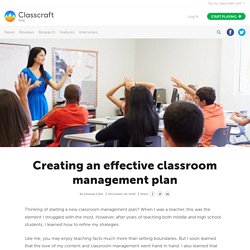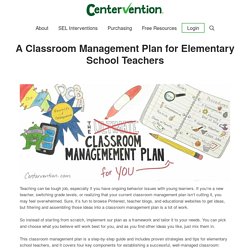

20 Classroom Management Strategies. Paper airplanes fly across the room. Students race between desks. You can’t get a word in, as they yell over you. It doesn’t have to be this dramatic, like a movie scene you’d watch in a media literacy lesson, but poor classroom management will almost assuredly elevate your stress and burnout rates. Unfortunately, 2006 research indicates that teachers overwhelmingly report lack of professional development support in improving classroom management. Despite this unideal situation, there are straightforward approaches you can implement by yourself. Available as a downloadable list to keep at your desk, below are 20 research-backed classroom management strategies and techniques.
Use the ones that best appeal to your situation and teaching style. Universal classroom management strategies 1. Make a habit of demonstrating behavior you want to see, as many studies show that modeling effectively teaches students how to act in different situations. Online & On-Site Student Behavior Training for Teachers. Online & On-Site Mindfulness Training to Support Student Behavior Calm Classroom offers mindfulness-based training for educators who are searching for a simple, accessible way to support behavioral issues in the classroom.

Our breathing, stretching, focusing and relaxation techniques help students develop emotional resilience and self-regulation skills so that they can better manage their emotions, leading to improvements in behavior and overall wellbeing. The Calm Classroom program is a perfect compliment to any existing behavior strategies being used in your school. With regular practice, our techniques bring focus and calm to any classroom and can be easily integrated into the academic schedule. How to Create an Effective Classroom Management Plan. Thinking of starting a new classroom management plan?

When I was a teacher, this was the element I struggled with the most. However, after years of teaching both middle and high school students, I learned how to refine my strategies. Like me, you may enjoy teaching facts much more than setting boundaries. But I soon learned that the love of my content and classroom management went hand in hand. I also learned that many of the same techniques worked in both middle and high school, but some cater better to one or the other. If you’re reading this article, you clearly already have your students in mind. Middle school classroom management plans Have classroom expectations In a previous article, I spent a lot of time talking about the importance of expectations. During the first week of school, consider having the students write down the rules they anticipate you’ll enforce. You might get that little joker who says that you should have recess all day. How To Set Up A Simple, Effective Classroom Management Plan.
The purpose of a classroom management plan is to hold students accountable for misbehavior—without having to yell, scold, or lecture. When used correctly, a classroom management plan eliminates the need to use these and other stressful, counterproductive methods. It allows you to demand impeccable behavior without causing friction and resentment. Which then frees you to build meaningful and influential relationships with your students. To set up a classroom management plan, you must first devise a set of rules that cover every conceivable misbehavior or disruption that could crop up in your classroom. I recommend the following four rules: Classroom Management. The Paradigm Challenge. About Project Paradigm And The Paradigm Challenge Project Paradigm’s mission is to identify, support, and collaborate with passionate individuals and organizations to inspire, lead, and facilitate paradigm shifts in the approaches to global challenges.

The Paradigm Challenge invites students aged 4 to 18 around the world to use kindness, creativity, and collaboration to help address real-life problems. The top 100 entries win up to $100,000 and the first place winners in each age division (4-8, 9-13, 14-18) win a 4-day/ 3-night trip to Los Angeles to attend The Paradigm Challenge Prize Ceremony. Teachers associated with the top 100 entries win grants up to $5,000. The annual deadline is May 1. The Paradigm Challenge is an annual global competition created by Project Paradigm in collaboration with the American Red Cross and a wide coalition of partners.
The Paradigm Challenge presents multiple high quality project based learning opportunities for students pre-K through 12. A Classroom Management Plan for Elementary School Teachers. Classroom Management Plan Rules Imagine a basketball game in which none of the players know the rules.

The referees would blow the whistle constantly, admonishing players for breaking rules they didn’t know existed. How frustrating would this game be for both the players and the refs, and for the fans in the bleachers? It would be chaos. In your classroom, you are the referee, your students are the players, and the fans are parents and guardians. Less is More Create a few straightforward yet inclusive rules for your classroom. We just gave you a lot of rules for writing classroom rules! “Something I do in my classroom that works great is to write the rules with my students,” explains Katy Jaeger, a first-grade teacher in Colorado.
Communicate with Parents Discuss the classroom rules with parents at open house, and send them home on the first day of school. Be Consistent Reinforce classroom rules consistently with all students, even in seemingly minor infractions. Procedures I do: We do: Attend.